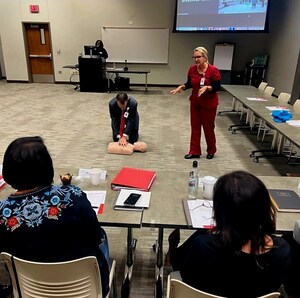American Heart Association Journal Report: Study Finds Racial Gaps Continue in Heart Disease Awareness, Low Knowledge of Heart Attack Warning Signs Among Women
DALLAS, Feb. 16 /PRNewswire/ -- Racial gaps exist in women's heart-health awareness, women's knowledge of heart attack warning signs requires attention and nearly half of women report they would not call 9-1-1 if they were having heart attack symptoms, according to new research published in Circulation: Cardiovascular Quality and Outcomes, a journal of the American Heart Association.
Results of the study, commissioned by the American Heart Association, revealed that although 60 percent of white women were aware of heart disease as the leading cause of death for women, less than half of African-American (43 percent), Hispanic (44 percent) and Asian (34 percent) women identified heart disease as the leading cause.
In addition, most women lacked knowledge of evidence-based therapies for preventing cardiovascular disease, and half of women ages 25-34 were unaware of heart disease as women's No. 1 killer, demonstrating the need for prevention education to avert death and disability from heart disease.
"The American Heart Association just announced its 2020 strategic goal: by 2020, to improve the cardiovascular health of all Americans by 20 percent while reducing deaths from cardiovascular diseases and stroke by 20 percent," said Lori Mosca, M.D., Ph.D, M.P.H., lead author of the paper and Director of Preventive Cardiology at New York-Presbyterian Hospital in New York City. "Our study shows that these goals will be virtually impossible to achieve without first creating awareness among multicultural and younger women, educating women about the warning signs of heart attack and underscoring the importance of calling 9-1-1 immediately if they are experiencing heart attack symptoms."
The study surveyed women to measure their current awareness of CVD risk and barriers to prevention and, from previous surveys, evaluated awareness trends since 1997.
For the 2009 survey, 2,300 women age 25 or older were interviewed (1,142 by phone; 1,158 online). Telephone data was used to understand changes since 1997.
In 2009, online respondents received additional survey questions about caregiving, preventive actions and barriers to healthy behaviors, to set a baseline for future data.
Of women surveyed by telephone, 54 percent understood that CVD is the leading cause of death among women, compared with 30 percent in 1997.
Additional survey findings:
- Since 1997, the gap between minority and white women's awareness of CVD as the leading cause of death has narrowed, with awareness roughly doubling among white and Hispanic women and tripling among black women.
- Knowledge of heart attack warning signs in 2009 has not improved appreciably since 1997, with only 56 percent of women citing chest pain and neck, shoulder and arm pain; 29 percent, shortness of breath; 17 percent, chest tightness; 15 percent, nausea; and 7 percent, fatigue.
- Only 53 percent of all women said they would call 9-1-1 if they thought they were having heart attack symptoms.
- Most respondents listed non evidence-based therapies to prevent cardiovascular disease, including the use of multivitamins (69 percent), antioxidants (70 percent), and special vitamins (58 percent); 29 percent cited aromatherapy as a preventive strategy.
- Of online respondents, the most commonly cited barrier to taking preventive action was family/caretaking responsibility, at 51 percent; confusing media reports was the next most common barrier at 42 percent.
- Community actions that online respondents thought would be most helpful in encouraging healthier lifestyles included access to healthy foods (91 percent) and public recreation facilities (80 percent), and listing of nutritional information in restaurants (79 percent).
The study highlights the need to sustain awareness and educational campaigns for women that incorporate evidence-based prevention messages, Mosca said.
"It's particularly important that national campaigns cut through the mixed messages women receive and deliver the facts about how they can prevent heart disease," said Mosca, also a spokesperson for Go Red For Women. "Despite recent research showing no benefit of antioxidant vitamins in women, the majority of women surveyed cited them as a way to prevent heart disease."
The authors note that the latest survey, which used a cross-sectional sample with an oversampling of racial and ethnic minorities, may represent a "best-case" scenario, because respondents were fairly well-educated.
The triennial tracking study was funded by the American Heart Association through a grant from Macy's Go Red For Women Multicultural Fund. Macy's is a national sponsor of Go Red For Women. The survey was conducted by Harris Interactive.
Co-authors are Heidi Mochari-Greenberger, M.P.H., R.D.; Rowena J. Dolor, M.D., M.H.S.; L. Kristin Newby, M.D., M.H.S.; and Karen J. Robb, M.B.A. Author disclosures are on the manuscript.
Statements and conclusions of study authors published in American Heart Association scientific journals are solely those of the study authors and do not necessarily reflect the association's policy or position. The association makes no representation or guarantee as to their accuracy or reliability. The association receives funding primarily from individuals; foundations and corporations (including pharmaceutical, device manufacturers and other companies) also make donations and fund specific association programs and events. The association has strict policies to prevent these relationships from influencing the science content. Revenues from pharmaceutical and device corporations are available at www.americanheart.org/corporatefunding.
CONTACT: For journal copies only, |
|
please call: (214) 706-1396 |
|
For other information, call: |
|
Megan Lozito: (214) 706-1359 |
|
Tagni McRae: (214) 706-1383 |
|
Julie Del Barto (broadcast): (214) 706-1330 |
|
SOURCE American Heart Association
WANT YOUR COMPANY'S NEWS FEATURED ON PRNEWSWIRE.COM?
Newsrooms &
Influencers
Digital Media
Outlets
Journalists
Opted In






Share this article